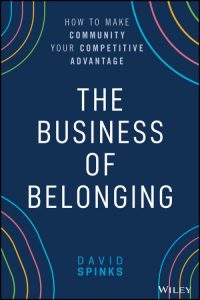How do you build a community-driven business? David Spinks shares his practical knowledge and extensive experience in building thriving communities in his new book The Business of Belonging.
When features are easy to copy companies have been turning into other aspects that are harder to imitate for competitive advantage. Community-driven businesses have realised many benefits that go beyond raising the switching costs for customers.
Spinks describes the community-building process from the start and shows the reality that many are not willing to admit. It takes a lot of effort, hustling, trials-and-errors, silent or no response disappoints at first.
There’s no one way to build a community nor can you just read a manual and expect it to work. Yet, there are methods, guidelines and processes that make it possible to succeed in the endeavour.
Community-driven businesses can have higher trust, lower costs and scale in their operations that touch every part of the organisation. The trick is to treat the community as a startup or a separate business that needs its metrics, resources and dedication for success.
Giving up control and trusting the community is one of the first and hardest hurdles. The top-down approach and regarding the community as an extension of the organisation or outsourcing outlet yield limited results. Communities have the numbers that can really help companies to grow in scale that would be even impossible otherwise. The control should be pushed down to the lowest level possible where the problems need to be solved and where the people are the most familiar with the issues.
Building communities take time from 6-12 months or even longer for starting to realise some business value. Yet, focusing on the business aspects alone will result in inauthentic communities that most likely will not thrive. Each community should focus on how it brings value to its members but also for the business. Community members are looking for belonging and emotional aspects as well.
Spinks reminds us that a community is a business and a business is a community. Great businesses serve people and build amazing cultures. Great communities are also financially sound so that they can keep fulfilling their purpose. To thrive, both need a good reason for their existence (i.e. mission and values) and a sustainable business model for continued operations.
The biggest reason communities fail is not lack of engagement but lack of resources. If you cannot measure and show the business benefits it’s hard to secure the resources and keep building the community. You need to be able to show how community engagement impacts company’s growth and revenues.
The book introduces SPACES (support, product, acquisition, contribution, engagement, success) model for measurable outcomes that communities will drive. The metrics for each aspect are familiar business goals such as customer lifetime value, reduced R&D time and costs, customer churn, reduced support & onboarding costs and times etc.
For the community and tactical level the book introduces two other frameworks that help to grow and build healthy communities with many practical tips, guides and words of wisdom.
If you’re thinking of building something together with other people Spinks has managed to put together an inspirational guide that is a must-read to walk you through the practical steps towards a vibrant community.

